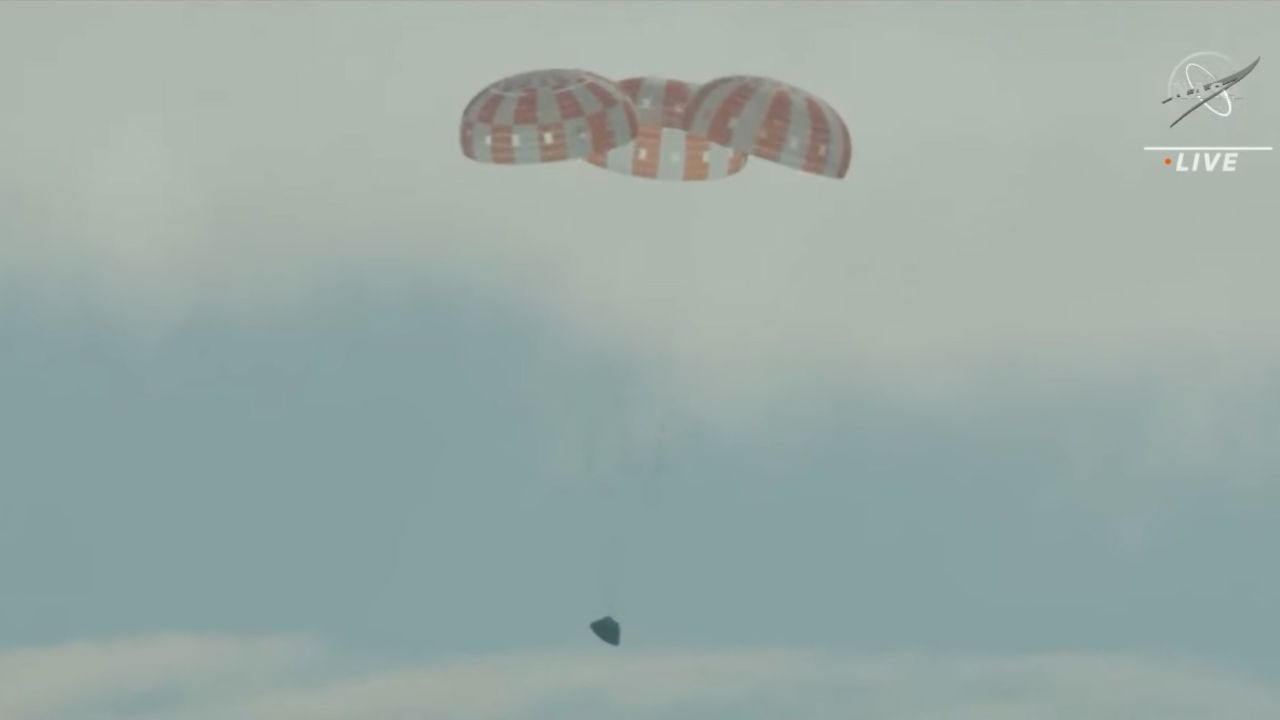(CNN) — NASA’s Orion spacecraft splashed down in the ocean, ending the Artemis I mission, a 25 1/2-day unmanned test mission around the moon intended to pave the way for future space missions.
The spacecraft completed the final leg of its journey, passing 239,000 miles (385,000 kilometers) between the Moon and Earth and approaching the dense inner layer of Earth’s atmosphere. It crashed into the Pacific Ocean in Baja California, Mexico this Sunday around 12:40 p.m.
The Orion capsule was scheduled to splash down near San Diego, but NASA officials said Thursday that rain, wind and large waves moved into the area and did not meet the space agency’s weather criteria.
NASA commentator Rob Navias, who led Sunday’s broadcast, called re-entry a “playbook” process.
The Orion capsule, with its three main parachutes, approaches the ocean surface. Credit: NASA/Youtube
This final step is one of the most important and dangerous stages of the work.
“We’re not out of the woods yet. The next big test is the heat shield,” NASA Administrator Bill Nelson told CNN in a phone interview Thursday, referring to the barrier designed to protect the Orion capsule from the unbearable physics of re-entry to Earth.
The spacecraft was traveling at 32 times the speed of sound (24,850 miles per hour or 40,000 kilometers per hour) when it hit the air, and compression waves heated the exterior of the vehicle to about 5,000 degrees Fahrenheit. (2,760 degrees Celsius). The extreme heat ionized the air molecules, creating a plasma, causing the expected blackout. According to Judd Frayling, Artemis I flight director.
When the capsule reaches an altitude of about 200,000 miles (322,000 kilometers) above Earth’s surface, it will perform a roll maneuver that sends it briefly upward, like avoiding a rock on the surface of a lake.
There are two reasons to try the jump maneuver.
“Gate jumps provide us with a stable landing platform that supports astronaut safety by allowing teams on the ground to better and faster coordinate rescue efforts,” said Joe Bamba, Lockheed Martin Aeroscience Aerothermal Lead at Orion. freedom. Lockheed is NASA’s prime contractor for the Orion spacecraft.
“By splitting the heat and force of re-entry into two events, the jump-in also provides benefits such as reducing the G-forces the astronauts are subjected to,” Lockheed said, referring to the crushing forces humans experience during space missions.
As it began its final descent, the capsule slowed dramatically, losing thousands of miles per hour until its parachutes deployed. Orion fell at a speed of 20 miles per hour (32 kilometers per hour).
Although there were no astronauts on this test mission – just a few dummies collecting data and a Snoopy doll – NASA President Nelson has emphasized the importance of proving that the capsule can return safely.
The space agency’s plans to turn the Artemis lunar missions into a program to send astronauts to Mars would involve a much faster and bolder re-entry process.

The Orion capsule captures a view of the lunar surface, illuminated in a crescent shape by the Sun against Earth’s background. (Credit: NASA)
Upon return from this mission, Orion will travel approximately 1.3 million miles (2 million kilometers) in a circular path toward distant lunar orbit, carrying the capsule. A distance that no spacecraft has ever traveled before Designed to carry people.
A secondary goal of the mission is the Orion Service Module, a cylindrical accessory on the base of the spacecraft that will house 10 small satellites. But at least four of those satellites failed after being launched into orbit, including a small lunar lander that was developed. Japan And one NASA’s own payloads It was supposed to be one of the first small satellites to explore interplanetary space.
On its journey, the spacecraft was captured Amazing pictures Earth and, when the two fly close, images of the lunar surface and a spectacular “Earth Rise”.
Nelson said that if the Artemis I mission had to be given a letter so far, it would be an A.
“Not A-plus because we expect things to go wrong. The good news is that when they do go wrong, NASA knows how to fix them,” Nelson said. But “if I were a school teacher, I would have given it an A-plus.”
If the Artemis I mission is successful, NASA will delve into the data collected on this flight and select a crew for the Artemis II mission, which could take off in 2024.
Artemis II aims to send astronauts on a similar trajectory to Artemis I, flying around the moon but not landing on its surface.
Artemis III Mission, It is currently scheduled for release in 2025This will include the first woman and the first person of color to set foot on the moon again, NASA officials said.





